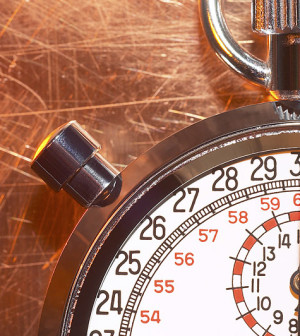- Navigating Your Midlife Crisis: Embracing New Possibilities
- City Raccoons Showing Signs of Domestication
- Mapping the Exposome: Science Broadens Focus to Environmental Disease Triggers
- One Week Less on Social Media Linked to Better Mental Health
- Your Brain Changes in Stages as You Age, Study Finds
- Some Suicide Victims Show No Typical Warning Signs, Study Finds
- ByHeart Formula Faces Lawsuits After Babies Sickened With Botulism
- Switch to Vegan Diet Could Cut Your Greenhouse Gas Emissions in Half
- Regular Bedtime Does Wonders for Blood Pressure
- Dining Alone Could Mean Worse Nutrition for Seniors
A Valentine’s Kiss Is Just a Kiss — Or Is It?

This Valentine’s Day, when people lean in for a kiss, the way they tilt their head may reveal a lot.
That’s the finding from new Canadian research that suggests people turn one way or the other, depending on whether the recipient of an affectionate kiss is a relative or a romantic partner.
Researchers Jennifer Sedgewick and Lorin Elias, of the University of Saskatoon, noted that prior research has already shown that people tend to turn their head to the right when kissing a romantic partner.
But what about when a person plants a peck on his or her child’s cheek?
To find out, the research duo analyzed hundreds of photos of parent-child kisses and compared them to pictures of romantic parent-parent smooches. The photos came from websites such as Google Images, Pinterest and Instagram.
They found that the moms and dads tended to turn their head to the left, not the right, when kissing their kids.
Why? Sedgwick and Elias theorize that the preference may be due to the fact that parents often cradle babies in their left arm and therefore kiss them in the same direction. That pattern probably continues even as the children get older, the researchers said.
And what about the right-hand turns for romantic smooches? According to the two investigators, prior research has shown that people in new relationships tend to have heightened activity in certain “reward regions” on the left side of the brain.
Turning right while kissing may boost the activation of these areas, the researchers theorized, pointing out that long-term couples tend to continue to turn right while kissing.
Sedgewick and Elias believe the new findings show that the direction the head is turned during a kiss is not only influenced by emotion, but also by the preference a person has for one side of their body — and learned behavior.
The study was published recently in the journal Laterality.
More information
For tips on keeping the romance in your relationship, head to the American Psychological Association.
Source: HealthDay
Copyright © 2025 HealthDay. All rights reserved.










